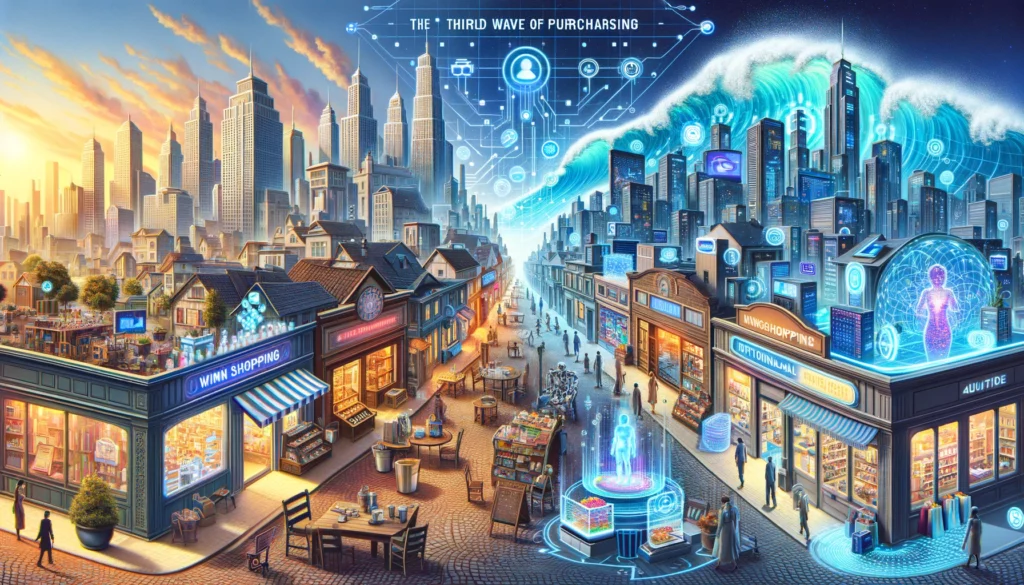The third wave of purchasing is rising with the power of AI. For online stores, adapting to Google’s AI shift, obtaining conversion data without relying on cookies, and responding to AI-driven changes are simply matters of life and death.
Buying is almost as old as time itself, but in the past people only bought what was available and what they could afford. Paid work, the development of science and technology, and the birth of brands have made purchasing more demanding. But now, from the buyer’s perspective, things are once again becoming easier, and the real challenge lies more on the seller’s side. The third wave of purchasing is rising with the power of AI.
In the past, bigger purchases were considered carefully. Money and supply were limited. Gathering information meant window-shopping, visiting stores, and talking to salespeople. Products often had brochures available in stores, or they could even be ordered by mail. Of course, many still follow these traditional practices, apart from the printed brochures and shop windows that have almost disappeared from city streets.
Search engines riding the second wave
With the rise of the internet, the first step in purchasing today is typing a keyword into Google’s search bar. That’s where the filtering of options begins—both in terms of product information and pricing. Often, more information raises new questions, and it’s easy to spend hours browsing websites, checking details, and weighing their importance. Especially if the purchase is of personal interest, one can quickly go through massive amounts of both useful and useless information.
The internet-enabled second wave of purchasing has already completely changed, for example, the nature of car sales. A potential second-wave customer gathers information independently, sometimes even sells to themselves, and generally takes care of things on their own. The salesperson’s job is to ensure their materials are in order and, above all, that the buyer finds and notices them. Search engine optimization, retargeting, and similar methods are therefore in use.
Tracking still works—whether you accept cookies or not
European Union regulations, led by GDPR, have limited tracking capabilities. Evidence of this can be seen in how everyone clicks cookie consent or denial buttons more than enough times every day. Often the latter, making tracking impossible for many but merely more difficult for us.
Relying on Google’s services, we have built a technological solution that still allows us to track visitors. At its core is a server dedicated to tracking and anonymizing tracking data. This makes it possible to continue measuring the effectiveness of advertising spend.
AI is envisioned as a supporter and assistant in knowledge work, boosting productivity and efficiency. This will also apply to purchasing, which is largely a knowledge-based decision-making process. Especially for technically complex and high-value acquisitions, AI will become a central support tool for purchasing.
Google brings AI to search results
Large language models that fetch real-time information from the web are gradually becoming common. In this way, AI can act just like a salesperson: listening to needs, making suggestions, answering questions—but unlike a salesperson, leaving the final purchase decision genuinely to the buyer. AI gathers people’s experiences and feedback, making it unnecessary to rely solely on the all-too-common salesperson’s “I’ve been happy with this myself” assessment.
Google is currently developing an AI feature for search results. The development project, called Search Generative Experience (SGE), aims to bring AI-generated insights into search results. It not only provides information but also sources and follow-up questions that have proven useful to ask the AI.
Google’s own service will undoubtedly evolve quickly, and soon even more specialized AI applications designed for purchasing will appear on the market. These may represent the next step—or even more advanced versions—of automatically operating price comparison sites. They also integrate recommendations from others as well as personalized suggestions based on a customer’s previous behavior. At the same time, AI nearly eliminates language barriers, making the EU’s internal market truly seamless even for consumer sales. For e-commerce businesses, this is both a threat and, above all, an opportunity.
Data accessibility drives commerce
Even though the exact tools developed for purchasing remain to be seen, behind it all lies machine-collected and processed data. Successful online stores have already invested in search engine optimization, but now this activity must be elevated to a new level. This deep optimization is precisely what we have been developing in recent years, and it has already proven effective in the second wave of purchasing.
In the not-so-distant future, one might open an app that already understands their needs and preferences, knows their sizes and tastes, and recalls past purchases. A consumer can train their own personal shopping assistant to meet different needs—from alerting them about new shoe models from a favorite brand to notifying them when salmon is served for lunch somewhere. And it will never suggest leopard print to someone who hates it, as long as it’s been trained accordingly. If such an app were fed with background data like a supermarket loyalty card, the targeting possibilities would be limitless.
Shopping is becoming virtualized
Trials and fittings will also change. Already today, one can test on a computer screen what a wall color or eyeglass frame would look like, but AI-based services will allow far more advanced possibilities. Clothes can be fitted onto a 3D-scanned image of a person, replacing mirror twirls with a screen video. AR applications can place items in real environments via a phone or tablet screen. Virtual reality glasses can create even more realistic service or trial situations. Meta’s much-hyped metaverse will likely become part of customer service at some point.
At the same time, chatbots that have so far been rather clumsy will improve significantly. However, they will be on the seller’s side, while the consumer’s app serves their own interests. How visibility—or even recommendations—will be sold into these bots and apps remains to be seen. It may even be that a consumer sets their buyer bot to chat with a seller bot and simply observes the conversation.
This change will also require new approaches in business marketing. What exactly those will be is not yet fully known. But what is certain is that the AI transformation has just begun and is accelerating rapidly. As with all technological shifts, giving competitors too long a head start can be fatal. This also requires a company’s partners to have the ability to keep up with the visible and very rapid change.
At Tovari, the year 2024 is dedicated to rising with the third wave of purchasing. If you want to enhance your marketing with AI and for AI, get in touch.

Sebastian Stenfors
sebastian@tovari.fi
040 014 9869
